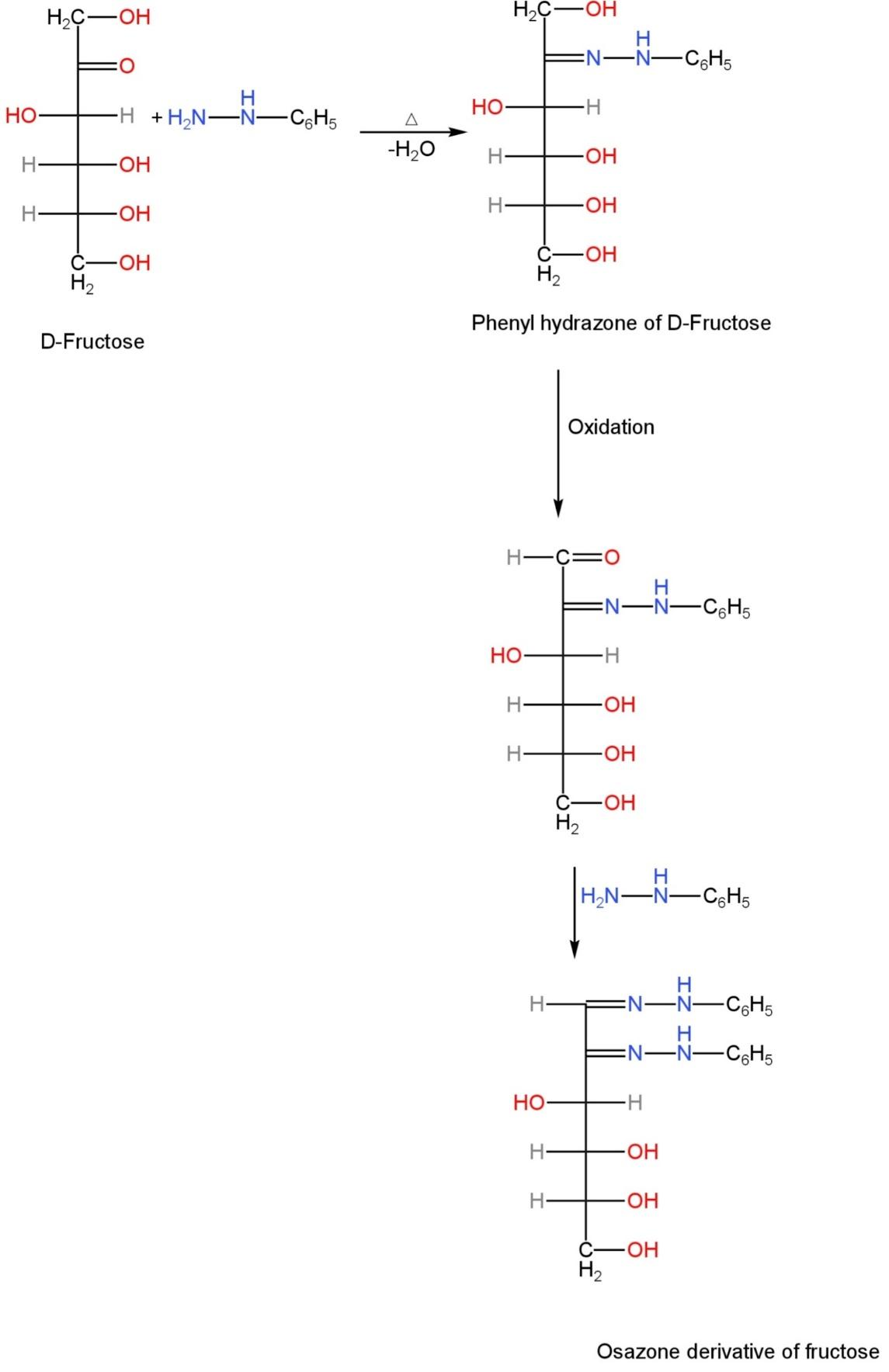
The reagent used for obtaining the osazone derivative of fructose is
A. \[N{H_2}OH\]
B. \[N{H_2}-N{H_2}\]
C. \[N{H_2}-NH{C_6}{H_5}\]
D. \[2,{\rm{ }}4 - DNP\]
Answer
224.4k+ views
Hint: Fructose, or fruit sugar, is a ketogenic simple sugar set up in numerous plants. Osazones are a category of carbohydrate derivatives formed from the reaction of reducing sugars with excess phenylhydrazine at boiling temperatures.
Complete Step by Step Answer:
Reducing sugar is any sugar that is apt to work as a reducing agent.
In an alkaline solution, a reducing sugar yields some aldehyde or ketone, which lets it work as a reducing agent, such as Benedict's reagent.
Every monosaccharide is a reducing sugar.
Fructose is a monosaccharide that has a ketone group.
So, it is a type of ketose that undergoes tautomerization to aldoses and then acts as reducing sugars.
Fructose in presence of excess phenylhydrazine forms an osazone derivative.
This reaction is a reduction of phenylhydrazine by fructose.
Fructose acts as a reducing agent by undergoing oxidation itself.
Hence, osazone is an oxidation product.
Step-1: The carbonyl group present in the fructose reacts with phenylhydrazine to form phenylhydrazone. During this phase, one molecule of hydrazine is used.
Step-2: This phenylhydrazone then reacts with two molecules of phenylhydrazine to form osazone.
The second molecule of phenylhydrazine oxidises the reactive hydroxyl group to develop the aldehyde group. This is because the ketone group had undergone a reaction in the first step itself.
Step-3: Lastly, the molecule of the phenylhydrazine that is left reacts with the newly created carbonyl group and converts fructose into osazone.
The mechanism is as follows:

Image: Mechanism of conversion of fructose into its osazone derivative.
Out of the given options, option C i.e., \[N{H_2}-NH{C_6}{H_5}\] is the formula for phenylhydrazine.
So, option C is correct.
Note: This reaction needs a free carbonyl group. So, reducing sugars like glucose, and fructose undergoes this type of reaction. Sucrose is a non-reducing sugar that does not constitute an osazone. Sucrose is a disaccharide sugar made up of glucose and fructose subunits. It has glycosidic bonds with the carbon atoms of fructose and glucose and its transition into an open-chain form with an aldehyde group is not possible as they contain a cyclic structure.
Complete Step by Step Answer:
Reducing sugar is any sugar that is apt to work as a reducing agent.
In an alkaline solution, a reducing sugar yields some aldehyde or ketone, which lets it work as a reducing agent, such as Benedict's reagent.
Every monosaccharide is a reducing sugar.
Fructose is a monosaccharide that has a ketone group.
So, it is a type of ketose that undergoes tautomerization to aldoses and then acts as reducing sugars.
Fructose in presence of excess phenylhydrazine forms an osazone derivative.
This reaction is a reduction of phenylhydrazine by fructose.
Fructose acts as a reducing agent by undergoing oxidation itself.
Hence, osazone is an oxidation product.
Step-1: The carbonyl group present in the fructose reacts with phenylhydrazine to form phenylhydrazone. During this phase, one molecule of hydrazine is used.
Step-2: This phenylhydrazone then reacts with two molecules of phenylhydrazine to form osazone.
The second molecule of phenylhydrazine oxidises the reactive hydroxyl group to develop the aldehyde group. This is because the ketone group had undergone a reaction in the first step itself.
Step-3: Lastly, the molecule of the phenylhydrazine that is left reacts with the newly created carbonyl group and converts fructose into osazone.
The mechanism is as follows:

Image: Mechanism of conversion of fructose into its osazone derivative.
Out of the given options, option C i.e., \[N{H_2}-NH{C_6}{H_5}\] is the formula for phenylhydrazine.
So, option C is correct.
Note: This reaction needs a free carbonyl group. So, reducing sugars like glucose, and fructose undergoes this type of reaction. Sucrose is a non-reducing sugar that does not constitute an osazone. Sucrose is a disaccharide sugar made up of glucose and fructose subunits. It has glycosidic bonds with the carbon atoms of fructose and glucose and its transition into an open-chain form with an aldehyde group is not possible as they contain a cyclic structure.
Recently Updated Pages
JEE Main 2026 Session 1 Correction Window Started: Check Dates, Edit Link & Fees

JEE Isolation, Preparation and Properties of Non-metals Important Concepts and Tips for Exam Preparation

Isoelectronic Definition in Chemistry: Meaning, Examples & Trends

Ionisation Energy and Ionisation Potential Explained

Iodoform Reactions - Important Concepts and Tips for JEE

Introduction to Dimensions: Understanding the Basics

Trending doubts
JEE Main 2026: City Intimation Slip and Exam Dates Released, Application Form Closed, Syllabus & Eligibility

JEE Main 2026 Application Login: Direct Link, Registration, Form Fill, and Steps

Understanding the Angle of Deviation in a Prism

How to Convert a Galvanometer into an Ammeter or Voltmeter

Hybridisation in Chemistry – Concept, Types & Applications

Ideal and Non-Ideal Solutions Explained for Class 12 Chemistry

Other Pages
JEE Advanced Marks vs Ranks 2025: Understanding Category-wise Qualifying Marks and Previous Year Cut-offs

Thermodynamics Class 11 Chemistry Chapter 5 CBSE Notes - 2025-26

Organic Chemistry Some Basic Principles And Techniques Class 11 Chemistry Chapter 8 CBSE Notes - 2025-26

JEE Advanced 2026 - Exam Date (Released), Syllabus, Registration, Eligibility, Preparation, and More

JEE Advanced 2026 - Exam Date (Released), Syllabus, Registration, Eligibility, Preparation, and More

Hydrocarbons Class 11 Chemistry Chapter 9 CBSE Notes - 2025-26




